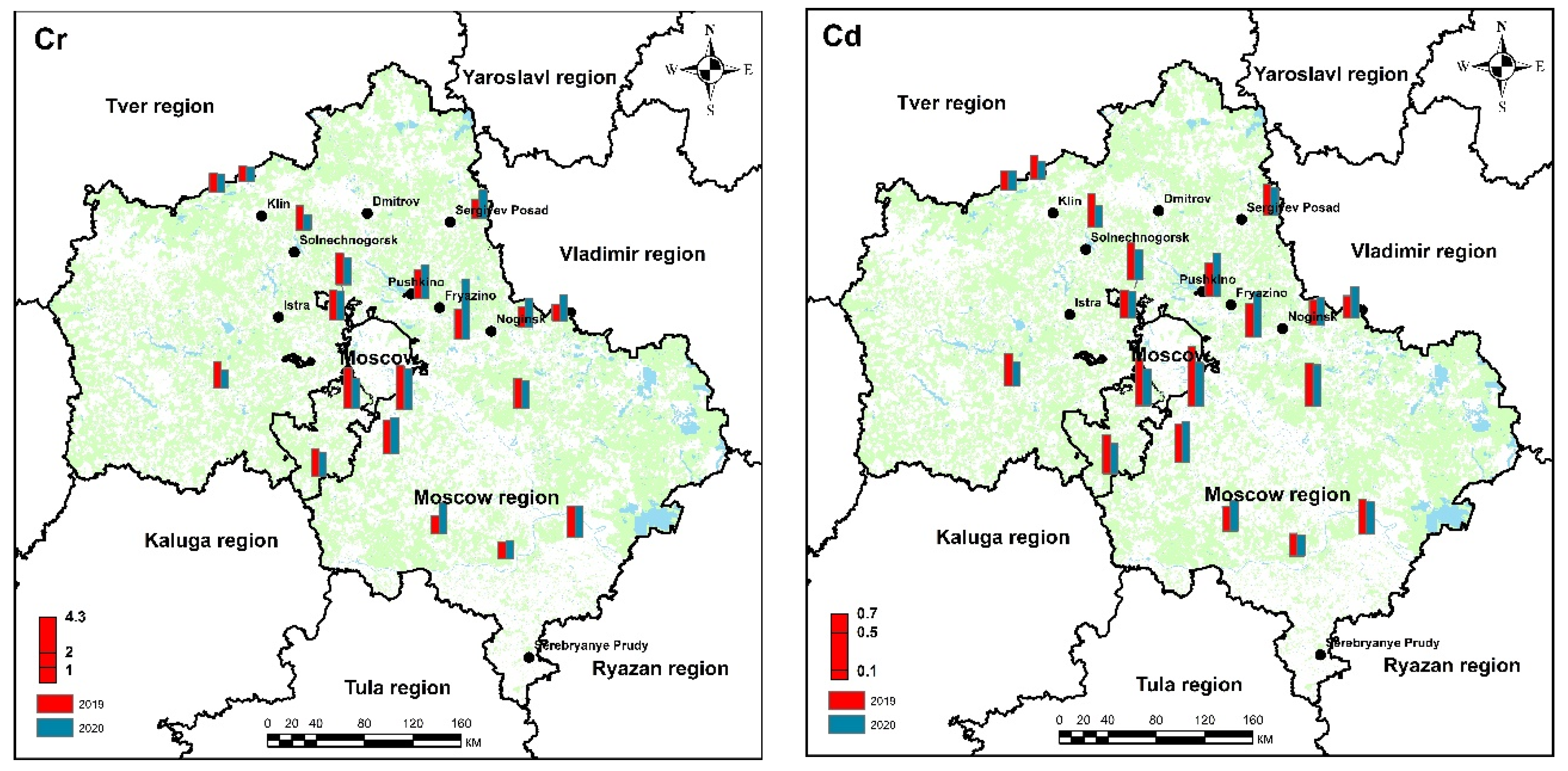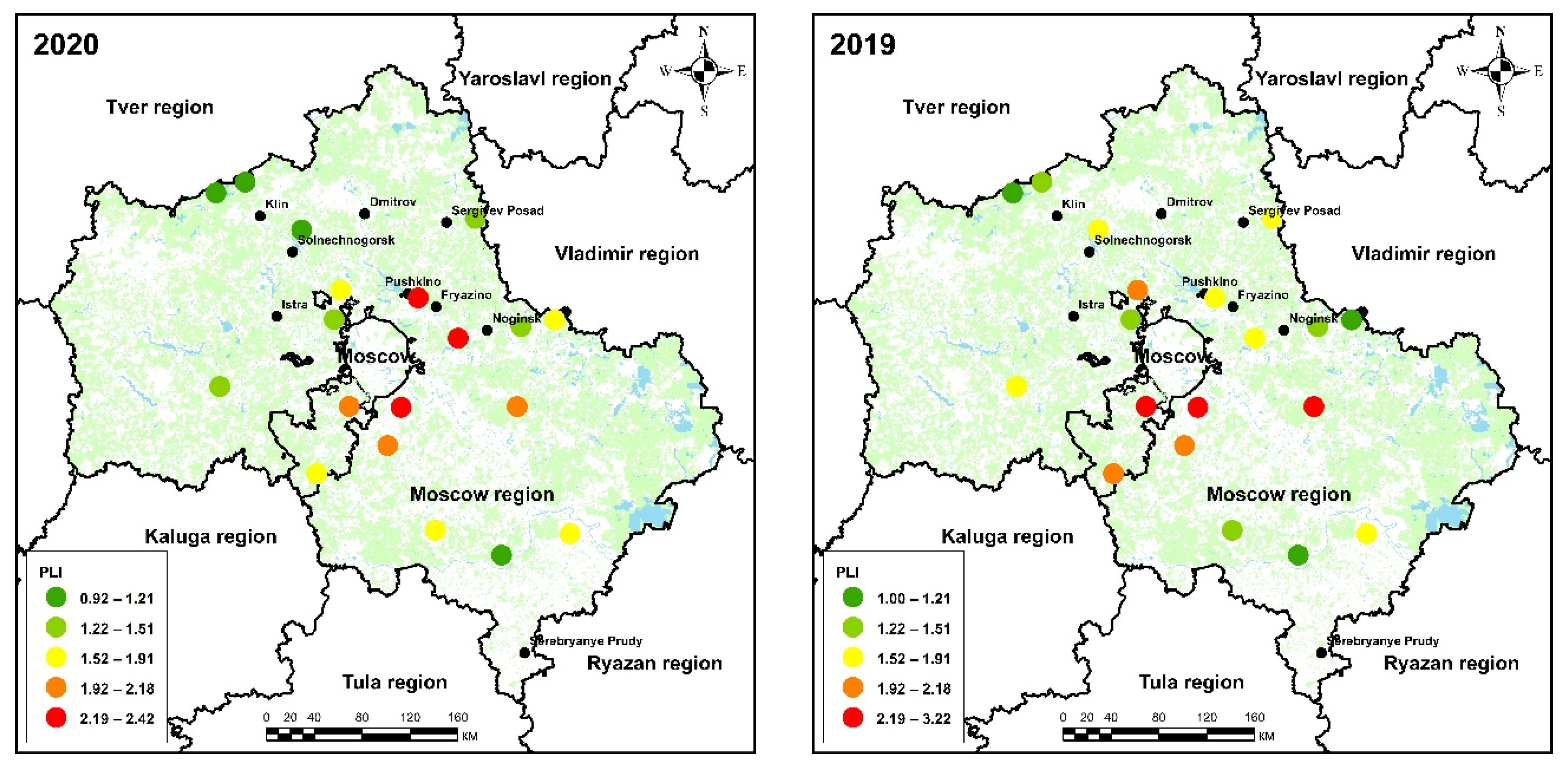Mosses as Bioindicators of Heavy Metal Air Pollution in the Lockdown Period Adopted to Cope with the COVID-19 Pandemic
Abstract
:1. Introduction
2. Experiments
2.1. Study Area and Sampling
2.2. Chemical Analysis
2.3. Data Processing
3. Results and Discussion
4. Conclusions
Author Contributions
Funding
Conflicts of Interest
References
- WHO Archived: WHO Timeline—COVID-19. Available online: https://www.who.int/news-room/detail/27-04-2020-who-timeline---covid-19 (accessed on 23 July 2020).
- Ma, C.J.; Kang, G.U. Air quality variation in wuhan, daegu, and tokyo during the explosive outbreak of covid-19 and its health effects. Int. J. Environ. Res. Public Health 2020, 17, 4119. [Google Scholar] [CrossRef]
- Nadzir, M.S.M.; Ooi, M.C.G.; Alhasa, K.M.; Bakar, M.A.A.; Mohtar, A.A.A.; Nor, M.F.F.M.; Latif, M.T.; Hamid, H.H.A.; Ali, S.H.M.; Ariff, N.M.; et al. The impact of movement control order (MCO) during pandemic COVID-19 on local air quality in an urban area of Klang valley, Malaysia. Aerosol Air Qual. Res. 2020, 20, 1237–1248. [Google Scholar] [CrossRef]
- Safarian, S.; Unnthorsson, R.; Richter, C. Effect of Coronavirus Disease 2019 on CO2 Emission in the World. Aerosol Air Qual. Res. 2020, 20, 1197–1203. [Google Scholar] [CrossRef]
- Zhang, J.; Cui, K.; Wang, Y.-F.; Wu, J.-L.; Huang, W.-S.; Wan, S.; Xu, K. Temporal Variations in the Air Quality Index and the Impact of the COVID-19 Event on Air Quality in Western China. Aerosol Air Qual. Res. 2020, 20, 1552–1568. [Google Scholar] [CrossRef]
- Xu, K.; Cui, K.; Young, L.H.; Hsieh, Y.K.; Wang, Y.F.; Zhang, J.; Wan, S. Impact of the COVID-19 event on air quality in central China. Aerosol Air Qual. Res. 2020, 20, 915–929. [Google Scholar] [CrossRef] [Green Version]
- Kaskun, S. The effect of COVID-19 pandemic on air quality caused by tra c in Istanbul. Res. Sq. 2020, 1–24. [Google Scholar] [CrossRef]
- Siciliano, B.; Carvalho, G.; da Silva, C.M.; Arbilla, G. The Impact of COVID-19 Partial Lockdown on Primary Pollutant Concentrations in the Atmosphere of Rio de Janeiro and São Paulo Megacities (Brazil). Bull. Environ. Contam. Toxicol. 2020, 105, 2–8. [Google Scholar] [CrossRef]
- Lequy, E.; Siemiatycki, J.; Leblond, S.; Meyer, C.; Zhivin, S.; Vienneau, D.; de Hoogh, K.; Goldberg, M.; Zins, M.; Jacquemin, B. Long-term exposure to atmospheric metals assessed by mosses and mortality in France. Environ. Int. 2019, 129, 145–153. [Google Scholar] [CrossRef]
- Markert, B.A.; Breure, A.M.; Zechmeister, H.G. Chapter 1 Definitions, strategies and principles for bioindication/biomonitoring of the environment. Trace Met. Contam. Environ. 2003, 6, 3–39. [Google Scholar] [CrossRef]
- Harmens, H.; Ilyin, I.; Mills, G.; Aboal, J.R.; Alber, R.; Blum, O.; Coşkun, M.; De Temmerman, L.; Fernández, J.A.; Figueira, R.; et al. Country-specific correlations across Europe between modelled atmospheric cadmium and lead deposition and concentrations in mosses. Environ. Pollut. 2012, 166, 1–9. [Google Scholar] [CrossRef] [Green Version]
- Harmens, H.; Norris, D.A.; Steinnes, E.; Kubin, E.; Piispanen, J.; Alber, R.; Aleksiayenak, Y.; Blum, O.; Coşkun, M.; Dam, M.; et al. Mosses as biomonitors of atmospheric heavy metal deposition: Spatial patterns and temporal trends in Europe. Environ. Pollut. 2010, 158, 3144–3156. [Google Scholar] [CrossRef] [PubMed]
- Vergel, K.N.; Frontasyeva, M.V.; Kamanina, I.Z.; Pavlov, S.S. Biomonitoring of heavy metals in the northeast of the Moscow region using moss-biomonitors. Ecol. Urban. Territ. 2009, 3, 88–95. (In Russian) [Google Scholar]
- Vergel, K.; Zinicovscaia, I.; Yushin, N.; Frontasyeva, M.V. Heavy Metal Atmospheric Deposition Study in Moscow Region, Russia. Bull. Environ. Contam. Toxicol. 2019, 103, 435–440. [Google Scholar] [CrossRef]
- Subregions, W.; Pulsipher, A. World Regional Geography Atlas; W.H. Freeman & Co.: New York, NY, USA, 2014. [Google Scholar]
- Spranger, T. Manual on Methodologies and Criteria for Modelling and Mapping Critical Loads & Levels and Air Pollution Effects, Risks and Trends; Umweltbundesamt: Dessau-Roßlau, Germany, 2004. [Google Scholar]
- Wilcoxon, F. Individual Comparisons by Ranking Methods. Biom. Bull. 1945, 1, 80. [Google Scholar] [CrossRef]
- Gonçalves, E.P.R.; Boaventura, R.A.R.; Mouvet, C. Sediments and aquatic mosses as pollution indicators for heavy metals in the Ave river basin (Portugal). Sci. Total Environ. 1992, 114, 7–24. [Google Scholar] [CrossRef]
- Fernández, J.A.; Carballeira, A. Evaluation of contamination, by different elements, in terrestrial mosses. Arch. Environ. Contam. Toxicol. 2001, 40, 461–468. [Google Scholar] [CrossRef]
- Okedeyi, O.O.; Dube, S.; Awofolu, O.R.; Nindi, M.M. Assessing the enrichment of heavy metals in surface soil and plant (Digitaria eriantha) around coal-fired power plants in South Africa. Environ. Sci. Pollut. Res. 2014, 21, 4686–4696. [Google Scholar] [CrossRef]
- Müller, G. Index of geoaccumulation in sediments of the Rhine River. Geol. J. 1969, 2, 108–118. [Google Scholar]
- Jorfi, S.; Maleki, R.; Jaafarzadeh, N.; Ahmadi, M. Pollution load index for heavy metals in Mian-Ab plain soil, Khuzestan, Iran. Data Br. 2017, 15, 584–590. [Google Scholar] [CrossRef] [PubMed]
- Williams, C.R.; Harrison, R.M. Cadmium in the atmosphere. Experientia 1984, 40, 29–36. [Google Scholar] [CrossRef]
- Adamiec, E.; Jarosz-Krzemińska, E.; Wieszała, R. Heavy metals from non-exhaust vehicle emissions in urban and motorway road dusts. Environ. Monit. Assess. 2016, 188, 369. [Google Scholar] [CrossRef] [PubMed] [Green Version]
- Hjortenkrans, D.S.T.; Bergbäck, B.G.; Häggerud, A.V. Metal emissions from brake linings and tires: Case studies of Stockholm, Sweden 1995/1998 and 2005. Environ. Sci. Technol. 2007, 41, 5224–5230. [Google Scholar] [CrossRef]
- Denier van der Gon, H.A.C.; Hulskotte, J.H.J.; Visschedijk, A.J.H.; Schaap, M. A revised estimate of copper emissions from road transport in UNECE-Europe and its impact on predicted copper concentrations. Atmos. Environ. 2007, 41, 8697–8710. [Google Scholar] [CrossRef]
- Yu, C.H.; Huang, L.; Shin, J.Y.; Artigas, F.; Fan, Z.H.T. Characterization of concentration, particle size distribution, and contributing factors to ambient hexavalent chromium in an area with multiple emission sources. Atmos. Environ. 2014, 94, 701–708. [Google Scholar] [CrossRef] [PubMed] [Green Version]
- Sanderson, P.; Su, S.S.; Chang, I.T.H.; Delgado Saborit, J.M.; Kepaptsoglou, D.M.; Weber, R.J.M.; Harrison, R.M. Characterisation of iron-rich atmospheric submicrometre particles in the roadside environment. Atmos. Environ. 2016, 140, 167–175. [Google Scholar] [CrossRef]
- Tian, H.Z.; Lu, L.; Cheng, K.; Hao, J.M.; Zhao, D.; Wang, Y.; Jia, W.X.; Qiu, P.P. Anthropogenic atmospheric nickel emissions and its distribution characteristics in China. Sci. Total Environ. 2012, 417–418, 148–157. [Google Scholar] [CrossRef]
- Wong, G.W.K. Air pollution and health. Lancet Respir. Med. 2014, 2, 8–9. [Google Scholar] [CrossRef]
- Barandovski, L.; Frontasyeva, M.V.; Stafilov, T.; Šajn, R.; Ostrovnaya, T.M. Multi-element atmospheric deposition in Macedonia studied by the moss biomonitoring technique. Environ. Sci. Pollut. Res. 2015, 22, 16077–16097. [Google Scholar] [CrossRef]
- Rutkowski, P.; Diatta, J.; Konatowska, M.; Andrzejewska, A.; Tyburski, Ł.; Przybylski, P. Geochemical referencing of natural forest contamination in Poland. Forests 2020, 11, 157. [Google Scholar] [CrossRef] [Green Version]
- Salo, H.; Bućko, M.S.; Vaahtovuo, E.; Limo, J.; Mäkinen, J.; Pesonen, L.J. Biomonitoring of air pollution in SW Finland by magnetic and chemical measurements of moss bags and lichens. J. Geochem. Explor. 2012, 115, 69–81. [Google Scholar] [CrossRef]




| Element | Year | Range | Md | Mean ± St. Dev | Q1 | Q3 | CV (%) | p |
|---|---|---|---|---|---|---|---|---|
| Cd | 2019 | 0.11–0.64 | 0.30 | 0.34 ± 0.14 | 0.23 | 0.41 | 41.9 | <0.05 |
| 2020 | 0.14–0.52 | 0.24 | 0.26 ± 0.09 | 0.22 | 0.30 | 33.9 | ||
| Pb | 2019 | 1.71–17.2 | 4.41 | 5.62 ± 3.45 | 3.80 | 7.02 | 61.4 | >0.05 |
| 2020 | 1.79–13.6 | 4.60 | 5.31 ± 3.14 | 3.21 | 6.26 | 59.2 | ||
| Cu | 2019 | 6.38–21 | 8.98 | 10.3 ± 3.93 | 7.29 | 12.9 | 38.3 | <0.05 |
| 2020 | 4.72–15.8 | 7.76 | 8.8 ± 3.18 | 6.64 | 9.36 | 36.3 | ||
| Cr | 2019 | 1.1–3.09 | 1.98 | 1.87 ± 0.58 | 1.32 | 2.16 | 30.8 | >0.05 |
| 2020 | 1.01–4.29 | 1.98 | 2 ± 0.75 | 1.46 | 2.18 | 37.6 | ||
| Ni | 2019 | 1.53–5.86 | 2.91 | 3.36 ± 1.17 | 2.67 | 4.27 | 34.9 | <0.05 |
| 2020 | 2.59–7.35 | 3.85 | 4.27 ± 1.27 | 3.37 | 4.61 | 29.8 | ||
| Fe | 2019 | 343–1175 | 579 | 607 ± 237 | 446 | 682 | 39.1 | <0.05 |
| 2020 | 309–2551 | 693 | 846 ± 476 | 594 | 933 | 56.2 |
| Element | Moscow Region 2020 | Moscow Region 2019 | Moscow Region 2014 [14] | Moscow Region 2004 [13] |
|---|---|---|---|---|
| Cd | 0.24 | 0.30 | 0.3 | x |
| Pb | 4.60 | 4.41 | 0.67 | x |
| Cu | 7.76 | 8.98 | 7.1 | x |
| Cr | 1.98 | 1.98 | 3.2 | 3.1 |
| Ni | 3.85 | 2.91 | 3.2 | 2.4 |
| Fe | 693 | 579 | 1050 | 800 |
| 2019 | Cd | Pb | Cu | Cr | Ni | Fe | |
| Cd | 1.00 | ||||||
| Pb | 0.76 ** | 1.00 | |||||
| Cu | 0.25 | 0.38 | 1.00 | ||||
| Cr | 0.43 | 0.60 ** | 0.71 ** | 1.00 | |||
| Ni | 0.28 | 0.14 | 0.28 | 0.55 * | 1.00 | ||
| Fe | 0.56 * | 0.48 * | 0.46 * | 0.66 ** | 0.36 | 1.00 | |
| 2020 | Cd | Pb | Cu | Cr | Ni | Fe | |
| Cd | 1.00 | ||||||
| Pb | 0.55 * | 1.00 | |||||
| Cu | 0.36 | 0.74 ** | 1.00 | ||||
| Cr | 0.41 | 0.67 ** | 0.66 ** | 1.00 | |||
| Ni | 0.42 | 0.39 | 0.61 ** | 0.73 ** | 1.00 | ||
| Fe | 0.22 | 0.69 ** | 0.61 ** | 0.71 ** | 0.40 | 1.00 |
| CF | Igeo | ||||
|---|---|---|---|---|---|
| Year | 2019 | 2020 | 2019 | 2020 | |
| Element | |||||
| Cd | 3.06 | 1.85 | 0.91 | 0.24 | |
| Pb | 3.28 | 2.96 | 0.93 | 0.77 | |
| Cu | 1.61 | 1.49 | 0.01 | −0.09 | |
| Cr | 1.39 | 1.58 | −0.17 | −0.02 | |
| Ni | 0.92 | 1.30 | −0.79 | −0.26 | |
| Fe | 1.74 | 1.48 | 0.12 | −0.17 | |
Publisher’s Note: MDPI stays neutral with regard to jurisdictional claims in published maps and institutional affiliations. |
© 2020 by the authors. Licensee MDPI, Basel, Switzerland. This article is an open access article distributed under the terms and conditions of the Creative Commons Attribution (CC BY) license (http://creativecommons.org/licenses/by/4.0/).
Share and Cite
Yushin, N.; Chaligava, O.; Zinicovscaia, I.; Vergel, K.; Grozdov, D. Mosses as Bioindicators of Heavy Metal Air Pollution in the Lockdown Period Adopted to Cope with the COVID-19 Pandemic. Atmosphere 2020, 11, 1194. https://doi.org/10.3390/atmos11111194
Yushin N, Chaligava O, Zinicovscaia I, Vergel K, Grozdov D. Mosses as Bioindicators of Heavy Metal Air Pollution in the Lockdown Period Adopted to Cope with the COVID-19 Pandemic. Atmosphere. 2020; 11(11):1194. https://doi.org/10.3390/atmos11111194
Chicago/Turabian StyleYushin, Nikita, Omari Chaligava, Inga Zinicovscaia, Konstantin Vergel, and Dmitrii Grozdov. 2020. "Mosses as Bioindicators of Heavy Metal Air Pollution in the Lockdown Period Adopted to Cope with the COVID-19 Pandemic" Atmosphere 11, no. 11: 1194. https://doi.org/10.3390/atmos11111194
APA StyleYushin, N., Chaligava, O., Zinicovscaia, I., Vergel, K., & Grozdov, D. (2020). Mosses as Bioindicators of Heavy Metal Air Pollution in the Lockdown Period Adopted to Cope with the COVID-19 Pandemic. Atmosphere, 11(11), 1194. https://doi.org/10.3390/atmos11111194






